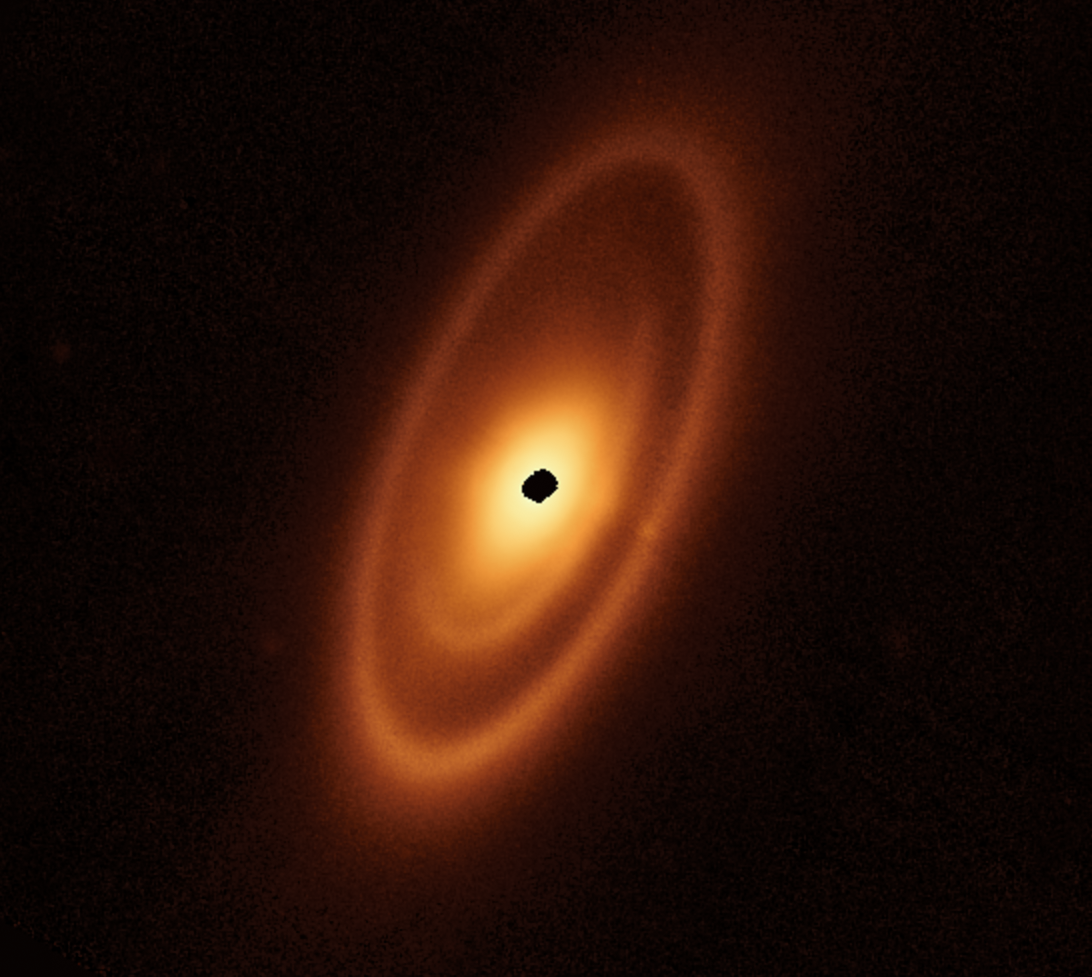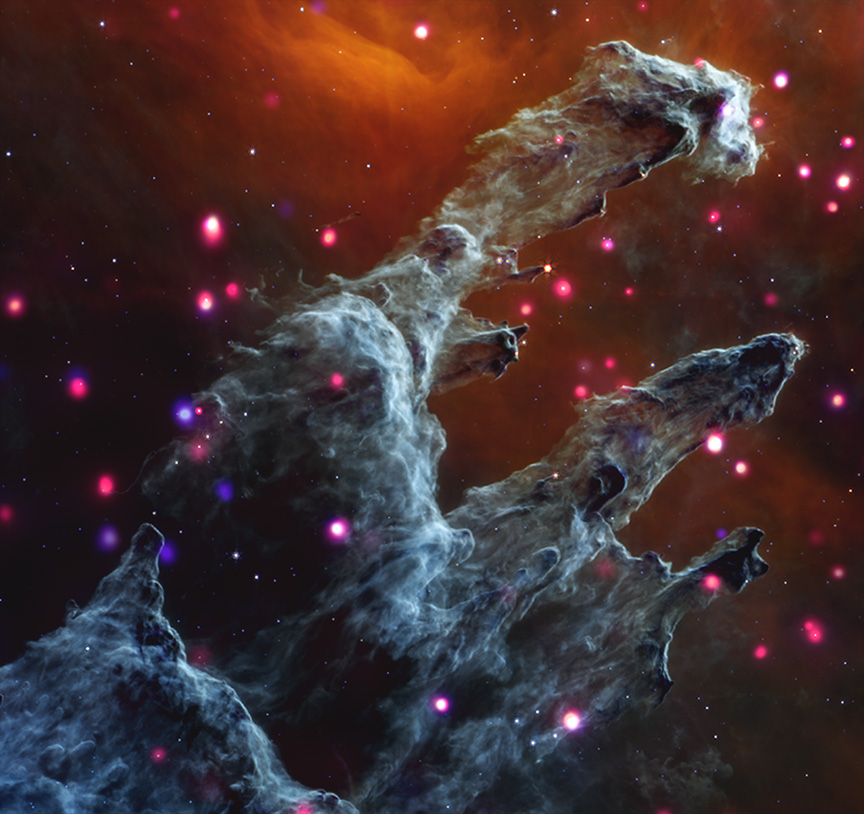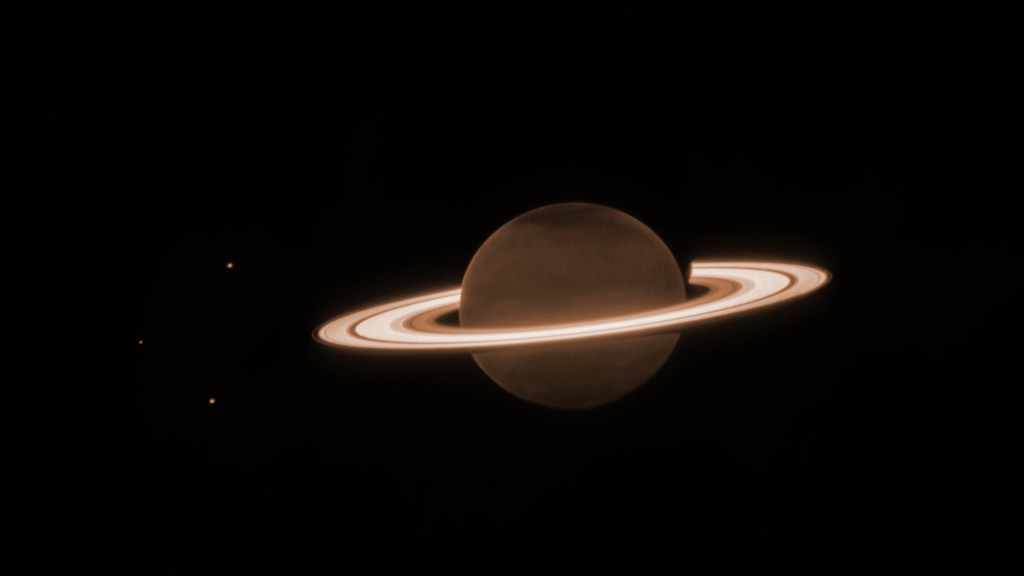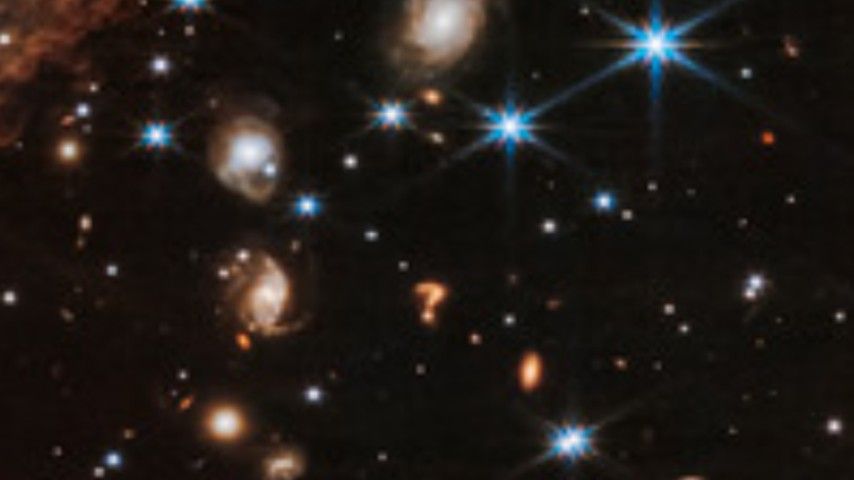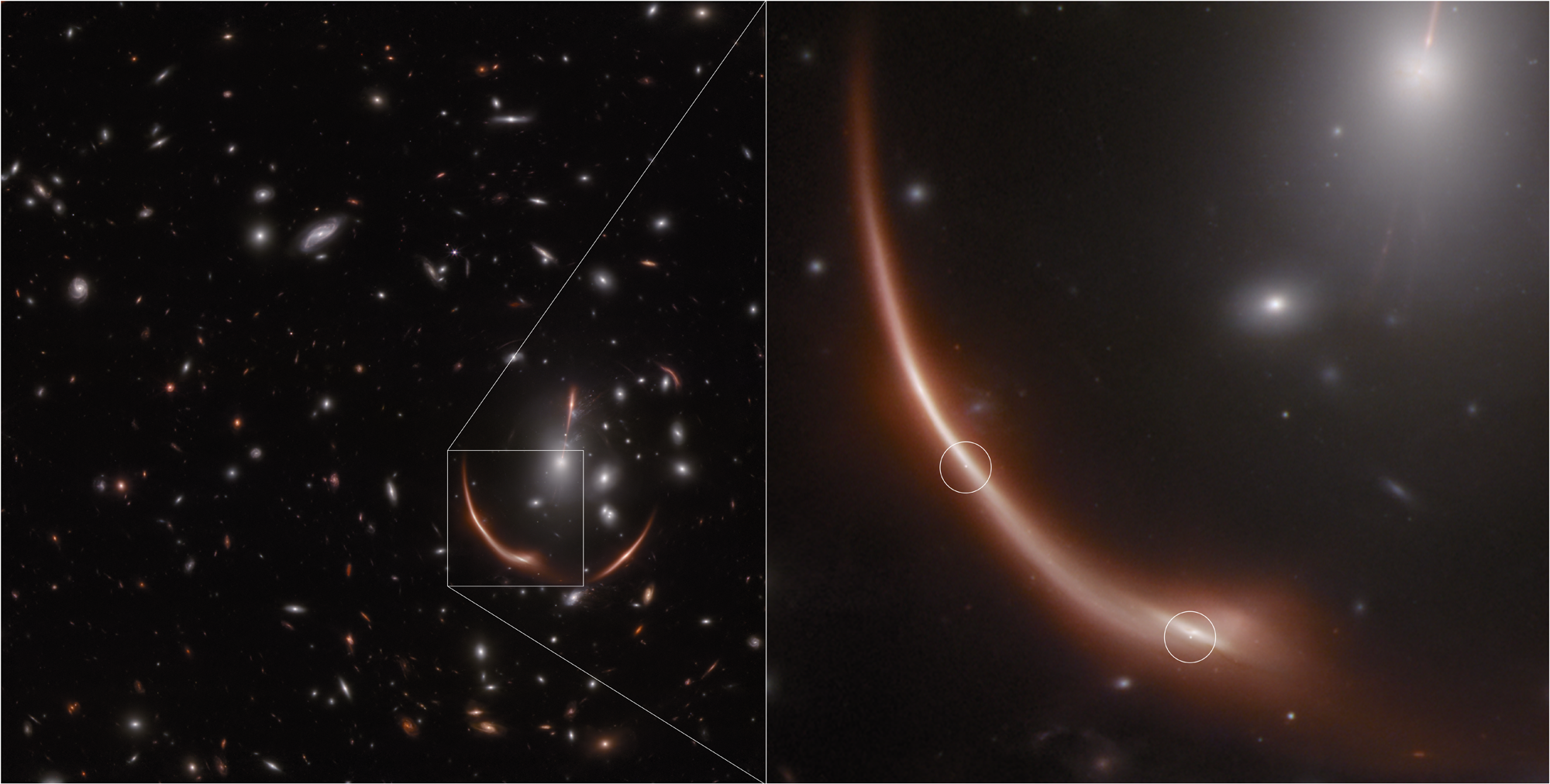This year, the James Webb Space Telescope (JWST), the largest and most powerful space telescope ever built, delighted researchers with stunning exoplanets, dying stars and 13-billion-year-old galaxies to reveal the secrets of the universe.
Launched two years ago, on Christmas Day, Webb measures primarily in the infrared range, from which it can not only glimpse the first galaxies, which formed a few hundred million years after the Big Bang, but also detect… Particles floating in planetary atmospheres. It revolves around distant stars. The space telescope, equipped with a main mirror with a diameter of 6.5 meters, orbits 1.5 million kilometers from Earth. Its sensitive detectors operate at a temperature of -223 degrees Celsius, and it is protected from heat by a multi-layer canopy.
In addition to breakthrough scientific discoveries, the James Webb Space Telescope will astonish the public with dazzling images in 2023, as its images show known galaxies, nebulae or planets in our solar system in a way that has never been seen before. Let's see what are the most exciting shots of the James Webb Space Telescope this year!
1. No planet, no star, but then what?
photo_camera
James Webb Space Telescope image of the inner Orion Nebula with dozens of UFOs inside
Image: NASA, ESA, CSA/Mark McCaughrian and Sam Pearson
In the Orion Nebula, which is located 1,300 light-years away from us, and which can be seen with the naked eye in the southern part of the Orion constellation, Webb found very special objects. These move in pairs and cannot be associated with any star. The approximately 40 pairs of celestial bodies are too small for mergers to occur, while their mass is similar to that of Jupiter, so experts refer to them as “Jumbo doubles.”
2. A special look at emerging planetary systems
photo_camera
The dust disk around the mouth of the large fish in JWST's mid-infrared image
Image: NASA, ESA, CSA, A. Gaspard (University of Arizona). Image processing: a. Bagan (STScI)
Hungarian astronomer András Gaspar led the research, as they observed a disk of dust around a nearby star, which James Webb revealed in unprecedented detail. This led to the discovery of asteroid belts orbiting the star Fishmouth that resemble similar regions in our solar system. According to the researchers, the observation confirms that James Webb's special capabilities provide insight into these emerging planetary systems in ways that were previously unimaginable.
3. The tireless pillars of creation
photo_camera
Source: NASA/ESA/CSA/STScI
There are few more famous astronomical images than the Pillars of Creation – the first was taken by the Hubble Space Telescope in 1995, but it's no surprise that the US space agency has now remixed the image to reveal active star-forming regions in the universe. Eagle Nebula every year. Last year, the James Webb Space Telescope captured the emission nebula in the near and mid-infrared range, and this year they combined one of Webb's images with observations from the Chandra the offer.
James Webb Space Telescope A near-infrared image of Saturn, its rings, and its moons, with a filter that blocks methane emissions from the planet's atmosphere.
Source: NASA, ESA, Canadian Space Agency, STScI
In addition to interstellar gas clouds, dust disks and planetary nebulae, Webb occasionally captures more famous celestial phenomena: this summer, for example, he captured a stunning image of Saturn – the fourth planet in the solar system. The image was taken using a special filter that blocks methane emissions, so it is unusually clear to see the planet's ring system and its three moons, Dione, Enceladus and Tethys.
5. The Eye of the Universe, the Ring Nebula
photo_camera
The ring nebula as captured by the James Webb Space Telescope's near-infrared camera (NIRCam).
Image: ESA/Web, NASA, CSA, M. Barlow, N. Cox, R. Wesson
Located 2,300 light-years from Earth, the Ring Nebula is interesting not only because it looks like a giant all-seeing eye, but also because, given its proximity, it's an excellent way to observe what's going on. It happens to stars like the Sun when they start to die. The star, which had been still glowing as a red giant for a few thousand years, continuously gave up most of its mass, the hot core still ionizing the escaping gas, as if by way of farewell, and the interior of the planet was revealed as a nebula composed of hydrogen and oxygen. This year's Webb images also revealed that the ring is made up of about 20,000 individual clumps of dense molecular hydrogen gas, each with roughly the same mass as Earth.
6. MZ/X, MZ/X, Apply!
photo_camera
Image: ESA/Web, NASA and CSA, A. Adamo and the FEAST JWST team
Unlike the Ring Nebula, the Vortex Nebula is a nebula in name only, but in fact covers spiral galaxy M51, located 27 million light-years away in the constellation Hunting Wounds. Its giant spiral arms are partly due to the gravitational influence of neighboring dwarf galaxy NGC 5195, but details of the regions between each arm have been revealed by infrared images taken by the James Webb Space Telescope. The dust concentrated along the spiral arms appears dark red, while the brighter parts hide areas of star formation, and the light of distant stars filters through the black bubbles that form inside the arms.
7. Cosmic question mark
photo_camera
?
Image: NASA, ESA, Canadian Space Agency. Image processing: Joseph DePasquale (STScI)
A space telescope usually answers researchers' questions, and it's rare for the universe to answer. This is what happened at the beginning of August: Webb took a photo of two stars being born in the Milky Way, and noticed a giant question mark on it. But how did this cosmic joke come about? According to astronomers, the reddish color of the object indicates that it is very far from Earth and was almost certainly formed as a result of the merger of galaxies.
8. Final explosion
photo_camera
Source: NASA, ESA, CSA, STScI, Webb ERO production team
The image was James Webb's first big shot of the year, and in the recording published in March, we were also able to capture a phenomenon we've never seen before: it captured a Wolf-Rayet star in the final phase of its life before it exploded into a supernova. Wolf-Rayets is the brightest, most massive and shortest-lived star, as is WR 124 in the constellation Sagittarius, 15,000 light-years away, which can be seen in the image. WR 124 is 30 times the mass of the Sun, and according to the snapshots, it has already lost enough material to last ten days – as the ejected gas moves away from the star and cools, it creates cosmic dust that emits infrared light that the James Webb Space Telescope emits. The tools can see in such detail that they can detect it.
9. The wonderful rings of Uranus
photo_camera
Uranus with its north polar cap, faint outer and inner rings, and nine of its 27 known moons (Rosalind, Puck, Belinda, Desdemona, Bianca, Portia, Juliet and Perdita).
Image: NASA, ESA, CSA, STScI
An image of Uranus was first published in April, taken by James Webb, and indeed in that image the ice giant's ring system was outlined in such detail as we had never seen before. They added a scoop to that in December: The faint, innermost dust ring was the first to show itself in the new image, but it also includes nine of its 27 known moons. In addition to Uranus' unique polar cap, storm phenomena have also been observed in the record, and studying them is not only essential for planning future Uranus missions, but can also help better understand the functioning of similar-sized exoplanets.
10. The colorful universe
photo_camera
Image: Space Telescope Science Institute/NASA, ESA, CSA, STScI, J. Diego
The fact that JWST is currently a favorite of astronomers does not mean that Hubble is no longer of interest to anyone. What's more, when the two space telescopes combine their forces, even more impressive results are produced: In November, they captured a detailed image of a vast galaxy cluster called MACS0416, 4.3 billion light-years from Earth, that no single space telescope can capture. Capable of image on its own. In the image, which was taken by combining visible and infrared light, the distances between objects that can be detected at different wavelengths appear in different colors, so the image can be safely called the most colorful image of the universe ever taken.
11. Hey Webb, George Lucas is getting his monsters back!
photo_camera
Red jets of young stars erupt in opposite directions, while a bright star lies at the center of the yellowish cave-like structure.
Source: NASA
According to NASA, we have never seen star formation like we saw in the Rho Ophiuchi Nebula in July On recording releasedWhich was timed to coincide with the anniversary of the first image from the space telescope. You wouldn't think it, but the cloud of dust and gas that looks like a monster from a Hollywood space opera is actually a quiet stellar cradle, where red jets of young stars are erupting.
12. (Almost) New Year's lens effect
photo_camera
Image: Space Telescope Science Institute, Office of Public Outreach/NASA, ESA, CSA, c. Beryl (STScI), Dr. Newman (Carnegie), A. Bagan (STScI)
In one of the last images released by the space telescope this year, the massive galaxy cluster is seen listening for the code signal MACS J0138.0-2155. Visible. The galaxy cluster's gravitational lensing effect not only bends and amplifies the light of the distant galaxy MRG-M0138, but also gives five different images of it at the same time. A supernova was found in the distant galaxy in 2019 by the Hubble Space Telescope, and researchers were surprised when they were able to identify another supernova in a James Webb image taken in November.









































